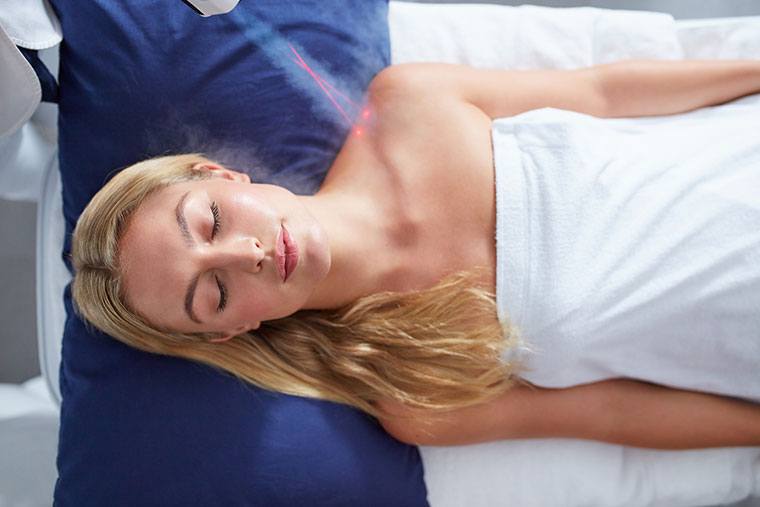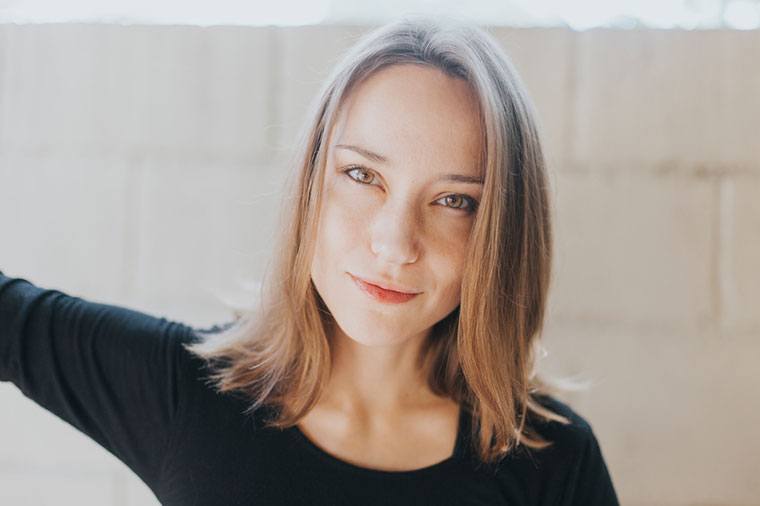Though I've always liked the cold (it's one of the main reasons I moved to New York from Texas, TBH), I've never been able to completely submerge in a cold plunge after a sauna sesh. So when I was asked to try a cryofacial—a treatment that subjects your skin to extreme deep-freeze temps—I hesitated a bit. Could I handle that level of chill? (After all, someone died in a cryotherapy chamber not too long ago.)
Of course, I'm supposed to try things like that in the name of beauty. And it's not a full-body treatment (AKA cryotherapy), which is when you stand in a pod at minus-250 degrees Fahrenheit, so I figured a quickie freeze on my face should be manageable.
"It removes the outer dead layer of skin cells and stimulates the new ones underneath them to grow in a more even, smooth distribution."
Instead, you're sprayed with subzero air—with exfoliation as the main benefit (you'll also look more awake, even if you haven't had your coffee yet).
"It removes the outer dead layer of skin cells and stimulates the new ones underneath them to grow in a more even, smooth distribution," says Doris Day, MD, a New York City-based dermatologist. "There are various ways to do this—you can use heat to gently burn it off, chemicals to melt it off, an abrasion-like microdermabrasion where you're physically forcing it off, dermaplaning to shave the layer, or cool it off with a certain temperature of cold air."
After a long (and yes, cold) winter, it sounded like just the thing I needed.
But is the treatment actually worth it? And are the intensely icy blasts as scary as they seem? I sought to find out.

What's the deal with freezing your face?
Super-frosty sessions can be very effective at helping your skin look smoother, especially if your shade is on the pale side, according to Dr. Day. (Guilty as charged.) And studies show that cryotherapy stimulates your collagen, so using it in a facial is a more targeted way to get that benefit, rather than in your smoothie.

{{post.sponsorText}}
The full-body treatment requires a three-minute session where your entire body is submerged (and literally chilling) in a minus-100 degrees or colder chamber. But with a cryofacial, an aesthetician blows freezing air in circles all over your face for just eight minutes.
But what about, er, frostbite? Dr. Day assures me nothing is in one spot long enough to cause any damage.
"The immediate result is a glowing and rested appearance, and long-term—after a series of sessions—[it will] help your overall skin quality and can eliminate small wrinkles," says Mila Jouravevla, nutritionist and owner of The Fuel Stop in New York City, which offers both kinds of cryo treatments. She says that since the sessions can lower inflammation, they're effective in treating acne and eczema, and can reduce puffiness and dark circles.
What about, er, frostbite? Seems like a legitimate risk, considering those temperatures you're exposing your face to. "You need to know who's doing the treatment," explains Dr. Day, who assures me that aestheticians will be waving the freezing air around in circles so it's not in one spot long enough to cause any damage.
But, a warning: If you have darker skin (or even if you're naturally pale and have a tan), you should skip it altogether. "It can create discoloration, so it's not something that everyone should do," she notes. "And I wouldn't use glycolic, retinoic, or salicylic acid for at least a few days before or after."

Taking the (icy) plunge
Just like with your typical run-of-the-mill facial, a cryofacial involves kicking back in a reclining chair or on a massage table. But instead of being sprayed with various nourishing elixirs and slathered with fancy creams, you'll undergo a purely mechanical process
At The Fuel Stop, it's up to me to decide whether I'd like any facial products applied beforehand. (I opt out, since I'm trying to stick to a regular beauty routine.) So the treatment itself is pretty simple and doesn't require much—well, besides the fancy machine.
As the aesthetician turns on the cryochamber—which has a hose-like tube connected to it that she can wave over my face—I steel myself for what I expect to be a cold beyond any blizzard in New York. Air starts streaming out in dreamy white poofs, much like the smoking caterpillar in Alice in Wonderland, and I close my eyes in preparation, punctuating it all with a here-it-comes deep breath.
Air starts streaming out in dreamy white poofs, much like the smoking caterpillar in Alice in Wonderland, and I close my eyes in preparation.
And then: complete shock. It doesn't feel unbearably freezing or like some sort of torture device. In fact, the blast of cold air is extremely soothing. You know how it feels when someone waves one of those old-school handheld fans at you on a swelteringly hot summer day? It's like that, taken to a whole other level—and very relaxing. My dream scenario would be an hour of that straight, but, alas—cryofacials max out at eight minutes (of pure bliss).
When I peer at my face in a mirror afterwards, I'm excited to see absolutely zero signs of redness or irritation—which is what I normally see after other facial treatments. Of course, Jouravevla had told me this beforehand, but that's something you have to see to believe. In the moment, my complexion's actually really glowy, porcelain-like (hey, I'm pale), and—honestly—the best it's ever looked.
As it turns out, my skin really needed to chill out. I have new respect for the power of cold, and while a weekly cryo session isn't realistic for me, I'm definitely thinking of my freezer as another beauty tool now. See you soon, turmeric ice cubes....
Here's what happened when one writer tried getting a facial (the regular kind) every single month. And these are the 10 skin-care commandments facialists live by.
Loading More Posts...